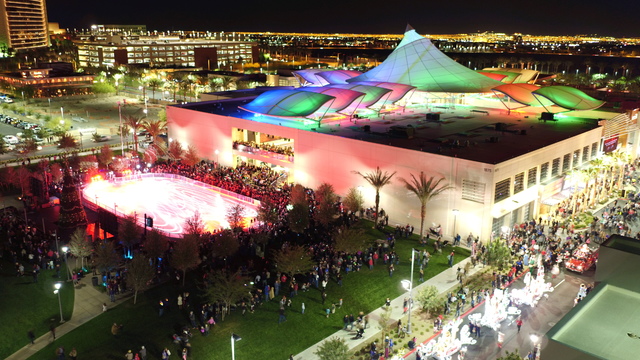


Las Vegas retailers will get a dose of holiday cheer this shopping season if revenue numbers meet the expectations of Los Angeles-based CBRE Group, the world’s largest commercial real-estate investment manager. The company tracks and interprets consumer spending statistics worldwide and forecasts strong retail numbers to end 2016.
“A lot of the projections hover around the 3.6 percent growth rate versus the same period in 2015 (2.5 percent),” said Melina Cordero, CBRE head of retail research for the Americas. “This reflects the consumer fundamentals that have been building, including wage and job growth that are enabling consumers to spend.”
Among the major trends for 2016 the company analysts identified was the continued growth of electronic commerce, although it remains a sliver of overall retail sales nationally, projected to account for 10.7 percent of holiday sales.
“Retailers have spent a long time building up their omnichannel platforms and consumer-facing, whether it is mobile apps or online,” Cordero said. “Almost all of the competition is taking place behind the scenes, in terms of how quickly they can deliver, how cheaply they can deliver.”
The rise of e-commerce has been especially beneficial to Southern Nevada, said Darin Mellott, director of research and analysis for the CBRE Southwest region. He believes online commerce has created a demand in the local market that otherwise would not exist in traditional retail models.
“There is a confluence of events, not just e-commerce but also costs relative to California, where again the key is, you have got to be close to the consumers,” he said.
“A lot of e-commerce firms, and those with e-commerce arms, are looking at Las Vegas as a market — as it can serve this large consumer base and is relatively close — but as they begin to look at their operations in a regional context, Las Vegas is actually well-placed to service consumers in the Northwest as well. Because of that, we are seeing activity in the Las Vegas industrial and logistics market that you just would not have seen before.”
In the race to provide the most immediate service, retailers are turning to non-traditional shipping options, such as Uber and Lyft.
“I think the new reality for retailers is about agility, being able to outsource on demand for delivery, returns and things like that,” Cordero said. “Because we are extremely demanding as customers today. The fact that we have our mobile phones in our pockets and can access millions of products at all times and can have it next day — we are demanding. We want things fast, and we want things cheap.”
She expects the categories of food and beverage, health and beauty, sporting goods and sporting apparel to perform strongly, as well as home goods, an area especially affected negatively during the recession.
Retailers who have reduced toy inventories year-round will look to expand their presence seasonally, with many turning to pop-up stores in available spaces the same way retailers provide Halloween-related products and apparel.
A major category in which sales are expected to remain sluggish is apparel, a trend Cordero says is forcing shopping centers to seek new strategies to attract customers.
“If you think of traditional regional malls, 50 percent of their leasing area is department stores — on average — and of the remaining 50 percent, 30 percent of that is apparel,” she explained. “So what you have is a situation where malls and shopping centers are dependent on an area that is not growing very much. And they need to diversify and look at areas that are less vulnerable to e-commerce.”
Health and wellness retail is one area of diversification many malls are seeking, as well as non-traditional entertainment attractions, such as the seasonal Rock Rink at Downtown Summerlin and the Seaquest Aquarium, opening Dec. 2 at the Boulevard Mall. Another trend is the demise of Black Friday as the designated day of touted sales to lure early shoppers.
“In past years it used to be Black Friday and everybody ran to malls — all the sales happened on that day,” Cordero said. “But now there are all these other days that take place in the lead-up to and even after Black Friday to drive sales. So those sales are being spread out throughout the month, which can be an opportunity for retailers. When the mall is not that crowded, people tend to stay longer and spend more.”
The shock election of Donald Trump to the U.S. presidency has caused significant fluctuations in world stock markets and deep apprehension in many Americans, but Cordero doubts those fears will create a significant impact on holiday consumer activities.
“We saw a little decrease in quarter three, and there is conjecture that this was from the uncertainty leading up to the election — consumers just weren’t sure what would happen and were holding back,” she said.
She said consumer confidence is a mCordero notes that changes in fiscal policy that accompany new administrations rarely are felt by individuals immediately, and she believes that realization will ease short-term spending apprehension.
Looking beyond the holiday season, Mellott expects Southern Nevada to benefit — at least in the short term — from an expansionary fiscal policy stemming from Republican control of the legislative and executive branches.
“We are looking at a combination of more defense spending, infrastructure, in addition to tax cuts,” he said. “What we think is that all of this amounts to a fairly stimulative policy over the short term. Depending on how they can move through this — we know the Senate majority is fairly slim — but given the ability to use certain procedural maneuvers, they can pass these large pieces of fiscal legislation. We actually see some potential upside as we move into the next year.”
Mellott noted possible downsides to proposed policies, including the risk of a trade war with key economic partners, which has the potential to trigger a worldwide recession.
“Provided a reasonable continuity in trade policy, we think the fiscal policy will actually put upward pressure on wages because the country as a whole has a relatively low unemployment rate,” Mellott said. “Low energy prices, lower taxes, higher wages — that is actually a good outlook for the consumer.”
But that might depend significantly on the current economic level of the consumer, according to Stephen Brown, Ph.D. of UNLV’s Lee Business School. “It is a trickle-down policy that largely favors providing bigger tax breaks for investment with the idea that it will stimulate economic activity,” he explained.
“In fact, what will happen is that we will see increased federal deficit and increased U.S. debt unless measures are taken to cut spending. And if you look at Trump’s plans on the spending side, it does not look like there will be lots of major cuts.”
Brown says the Republican congress might introduce bills intended to reduce spending, focused largely on social services, but that the income tax reduction is unlikely to pay for itself through economic growth, based on historical precedent and analysis of current factors.
“Trickle-down tax cuts do stimulate the economy to some degree,” he said, “but I don’t think they help the working-class person very much.”







